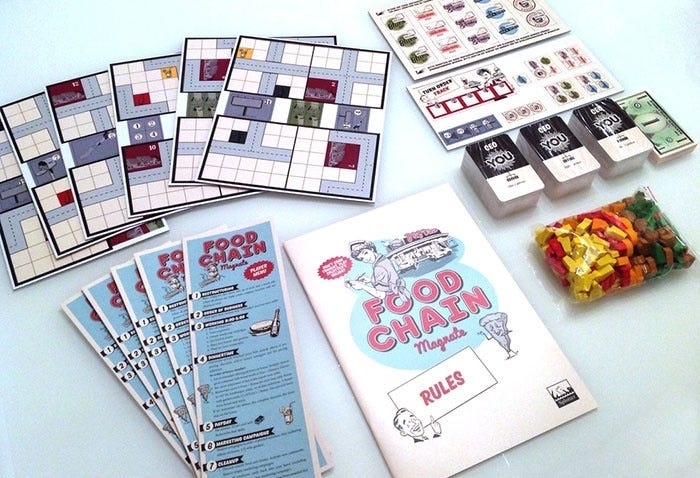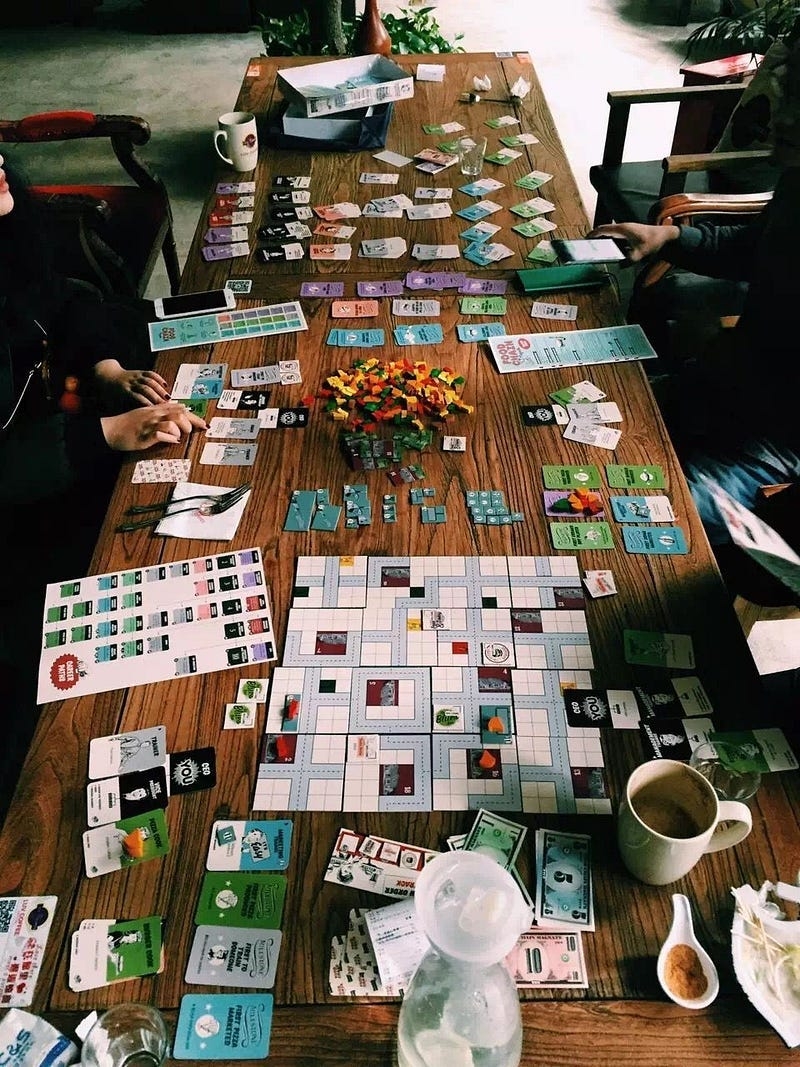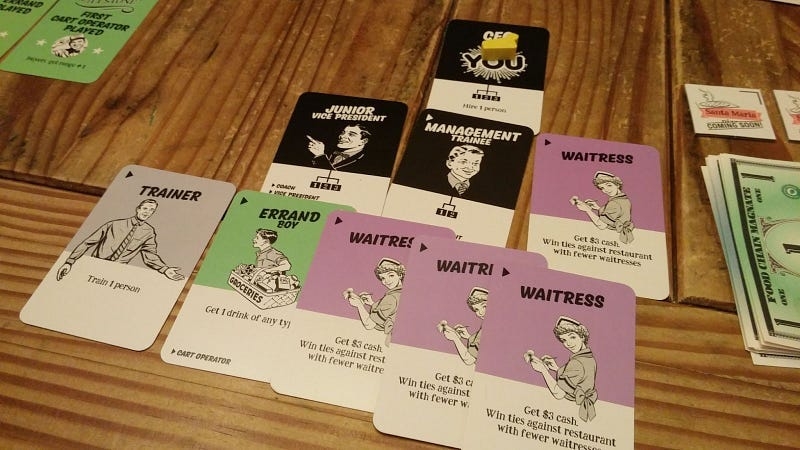Unblocking On-Chain Games: Part Four — Food Chain Magnate

Will Robinson
·Mar 29, 2023

Components for Food Chain Magnate (Doumen & Wiersinga 2015)
This is Part Four of a series exploring constraints at the intersection of blockchains and games. The objects of inquiry are “autonomous worlds”, “crypto-native” or “on-chain” games, which trustlessly maintain their game state.
About me: I’m a core contributor to Alliance DAO, a startup accelerator and founder community. I hold a PhD in Game Design.
Food Chain Magnate
Last month, I presented at ETHDenver on the five major problems facing fully on-chain games. The last, and perhaps thorniest is in finding game design patterns that are appropriate for blockchain’s as a medium. In the first post of this series, I mentioned a few games that might be particularly suited to being built on-chain. In this post, I dig deeper into one of them, Food Chain Magnate (Doumen & Wiersinga 2015). You take on the role of a fast food franchise founder, inspired by the likes of Ray Kroc. Your goal is to convince suburban homes that they want fast food, and then sell it to them at the most affordable price in the most convenient location. You are going to need to carefully choose where to open restaurants, how to advertise and, most importantly, whom you hire and train.

A couple turns into a round of Food Chain Magnate.
The best games are unintuitive. That is what makes them meaningfully challenging. I find it easiest to describe a game by the ways you may misunderstand its rules. Here are some notable mistakes I made in FCM that cost me sweet sweet victories.
- I spent a lot of time advertising hamburgers and ensuring that I could supply them at great prices. However, my opponent convinced my customers that they wanted to drink lemonade alongside those burgers. I was caught with my pants down, as I had no beverage distribution network. Even though their burgers were more expensive and inconvenient, they got to sell and I couldn’t make payroll.
- I hired nearly every waitress under the sun to generate early cash flow (my restaurants were more like Hooters than McDonalds I guess?). With this cash I hired more expensive talent to outpace my opponents. Unfortunately, I neglected to train up my managers, who were eventually overwhelmed with staff. I was not able to field all of my hires, causing my workforce to become game-losing-ly inefficient.
- I decided to compete with my opponent on generating profit through pizza sales, but had not considered the ramifications of the bonus he received for being their inventor. With every sale of a pizza, he would make an additional $5, regardless of the price. My own bonuses allowed me to out-scale him (offering pizza at three times as many locations) but he quickly realized that he could undercut my pizza by 80% and still be profitable. Even though I was all over the map and pumping out pizzas en-masse, all the suburbanites were willing to travel to his distant joint to save a couple bucks. By the time I got around to slashing my prices, it was too late.

Here is a company that is looking to generate early cash flows with waitresses. Notice how stretched the management team is.
Why Port it to Chain?
This game has a few key features that make it an ideal candidate for an on-chain game:
Player Quantity Agnostic
First, Food Chain Magnate can be designed to support any number of players. There are two reasons for this:
- Because the scoring phase “a.k.a. Dinnertime” affects all players simultaneously, they do not need to wait for each other to finish their turn. Some phases do have sequential play, but you could parallelize them with some quick changes. Then players could commit their moves simultaneously. Instead of having to wait your turn (which is standard in older games like Clue, Monopoly, or Risk), players can move in parallel.
- The map grows with the number of players, as do the number of bonuses for achieving early milestones. For instance, the first person to hire a waitress makes $2 more per waitress employed. But everyone who hired a waitress on the turn where the first waitress was hired also receives the bonus. While the game is normally set for three to five, it could be set for dozens or even hundreds.
No Mid-Game Randomness
Second, there is no random chance during gameplay. While the board is randomly generated each game, and while the game length is dependent on when the bank runs out of money, there is no deck of cards needing shuffling or dice to be rolled. Without the need for fairly generated randomness, the game does not need to pay for outside oracles or ruin UX with awkward randomness generating structures.
Lots of Thinking, Batched Doing
Third, the game is heavy, meaning there is a lot to think about. This is in part because moves require lots of nested decisions. Boardgamegeek rates it at 4.21 out of 5 for weight, making it the 6th heaviest game in the top 50. A two hour game usually has 10 rounds, where each round could require at most three state changes from each player. That is one move every four minutes. A 40 TPS chain could handle nearly 10,000 concurrent players.
Guaranteed Fun
Fourth, the game is hecking fun, albeit unknown. Splotter Spellen famously does not advertise and their boxes are ugly (for instance, the backs of their boxes are just white cardboard). They cater to a very small niche of gamers who do not mind spending $150 on a great game. Instead of putting their efforts into visual design and marketing, they build novel game mechanics and balance the heck out of them. So while their competitors have mass Kickstarter campaigns, short learning curves and target big box stores, Splotter Spellen just looks to have a couple thousand people fall in love. I suspect that their other flagship games, Roads & Boats, as well as Indonesia would be suitable for blockchain too.
But what makes this particular game fun? Here are a few mechanics worth highlighting, as each leads players to enjoy deep thinking (think of this as leveraging off-chain computing 😘):
- It is costly both to build the market, advertise to it and then supply it. A player who spends too much time growing demand for goods (either by lobbying to develop suburban dwellings or through ad campaigns) will be beaten by a player who focuses on an agile production line, looking to reap the rewards sown by their opponents. Conversely, a player who exclusively focuses on manufacturing will never be able to shape their market to their will.
- There are too many things to do and nowhere near enough actions to complete them. Players need to hire, train, market, cook, deliver, develop suburban areas, open new restaurants, reprice, and so on. Each of these things is critical for a player's success, and yet only a fraction of them can be accomplished by any given player. Ruthlessly poring over opportunity costs is exhilarating.
- Variable strategies progress in varied ways. Since there are so many things to do, and because Splotter spent so much time balancing them, there are lots of great ways to try and win the game. But on top of that, the first person to complete some milestone, such as launching the first add campaign or cooking the first burger, each strategy will be inflected part way through with player specific bonuses.
Conclusion
Building on-chain games remains extremely hard. However, since my last few posts, notable improvements have been made on the tooling level, the community has grown (the secret Telegram group I am in has gone from 17 to 105), and new examples of fully on chain games are being playtested. I’d like to also make a shoutout to 0xhank (my fearless editor) took my last post to heart and has started building Dark Seas, a naval battle game which has captured the hearts of the on-chain gaming community. So far, it has been a delight to playtest. To give it a try, join the Small Brain Games discord: https://discord.gg/FDvGVgFN.
And remember, if you want to talk about building fully on-chain games, or if you are already working on them, please please DM me on Twitter at @DangerWillRobin.
More to Read
You're Vibe Coding Wrong

Mohamed Elseidy
·Jul 10
Most developers use Tier 1 for UX & rapid prototyping, Tier 2 for daily development, and Tier 3 for complex engineering challenges. The best strategy is to combine them when needed rather than trying to force one tool to do everything. Here's what each tier actually delivers and when you should use them
Your Moat Isn't Your AI Prompt. It's Your Evaluations

Mohamed Elseidy
·Jun 17
Anyone can copy a prompt, but they can't replicate the months of iterative learning, the domain knowledge and the edge cases discovered through real user interactions, and the systematic evaluation framework that guided every prompt tweaking decision.
Shopping is Dead, AI is Taking Over

Mohamed Elseidy
·May 28
Major payment networks are building the infrastructure while AI platforms began to deploy; for startups, this opens opportunities in vertical specialization and merchant tools; and SEO will evolve into AEO as businesses adapt to optimize for AI agents rather than human shoppers.